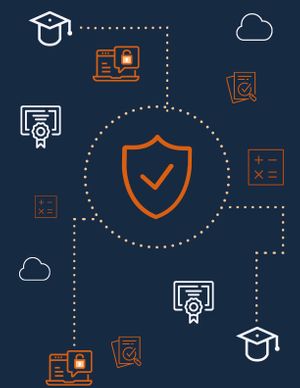Dealing with cybersecurity threats can feel like navigating the wild west. Knowing how to arm your IT and security teams with the right personnel, policies and tools can be an overwhelming burden. In our series of five blogs, we’ll walk through some top security priorities for your organization to consider, starting with upgrading your IT and data security.
Protecting your organization’s data isn’t a one-size-fits-all task. Your IT and security teams’ size and budgets affect which practices and tools can be successfully implemented. Let’s walk through a few you can add to your arsenal that can make a big impact.
Artificial intelligence and machine learning
If you’re on social media, you’ve likely caught wind of the fear AI art and AI chatbots have given people. While the results of these AI are interesting, they also incite questions surrounding how AI will influence the value of human creativity in the future. One thing is for certain: AI is here and here to stay.
Thankfully, AI doesn’t have to cause career-related existential crises. Using machine learning, AI enhances your cybersecurity posture by digesting enormous datasets and log files, predicting how bad actors will structure future threats and proactively defending your systems beyond the capabilities of human staff. And AI’s ability to speedily handle and analyze large datasets means it’s an excellent tool for anomaly detection and threat hunting, even beyond the abilities of seasoned security professionals. This means IT and security staff can spend their valuable time on other priorities—a relief, especially for small teams.
How can security teams leverage AI and machine learning?
According to a 2022 IBM study on AI and automation for cybersecurity, AI adopters gain the most benefit in these areas:
- Triage of Tier 1 threats
- Detection of zero-day attacks and threats
- Prediction of future threats
- Reduction of false positives and noise
- Correlation of user behavior with threat indicators
In other words, integrating tools that use AI into your cybersecurity workflow, such as SIEM software or endpoint protection not only help with active threat detection, but prevent threats that have yet to be developed from exploiting your system. Not to mention AI and automation can save your organization money and time—companies with a fully deployed program identify and contain data breaches 28 days faster than those who don’t.
Mobile device management (and beyond)
The AICPA, the governing body for industry-standard SOC security audits, published a cybersecurity checklist in 2022 that includes these security recommendations:
- Set computers to automatically update the operating system and key applications
- Use enhanced password controls and enforce password policies
- Ensure only trusted, validated users and equipment can connect to IT resources
- Document all firm-owned equipment
What all of these have in common is that they can be achieved using mobile device management (MDM) or enterprise mobility management (EMM) tools. Unified endpoint management (UEM) combines the two in a solution that can secure and control the IT environment and endpoints while keeping company and personal data under lock and key.
What does this mean for IT and security teams?
Device management allows IT to:
- Push operating system updates and important patches to keep devices in compliance and up to date
- Enforce password policies, including complexity and expiration
- Limit access to company data by restricting app usage to approved apps
- Strictly confirm user identity with zero trust when accessing company resources (more on access control later in this blog series)
- Keep data-rich inventory of devices used by employees, including BYOD
- And more!
Management tools give IT personnel transparency into their device fleet so they don’t have to remain in the dark about the security of their devices. Device management solutions can also streamline the onboarding process by allowing for zero-touch implementation—a convenient feature especially with a work-from-home workforce.
Data privacy
Ultimately, using AI for threat prevention and device management for endpoint protection and management helps achieve the goal of data privacy. But these tools alone can’t promise your company data stays away from prying eyes. How your data is stored is important as well: do you have on-premises or cloud servers? Or perhaps a combination of both? Are company devices encrypted? What happens if your data is breached? Do you have backups to restore to during the recovery process? How can we preserve the confidentiality, integrity and availability of our data?
Activity monitoring: AI comes in handy here again as it process information about who accesses data, discovers anomalies and identifies potential risks.
Vulnerability assessments and risk analysis: Performing regular assessments of devices’ security and compliance reduces risk of exploits. If applicable to your organization, penetration testing can reveal weak points in your security posture.
Access controls: Especially important in cloud environments, users should be given “least-privilege access” throughout the entire IT ecosystem. Consider zero trust network access to ensure only trusted users and devices access company resources.
Backups: Regular tested backups should be maintained and subject to the same security controls as any other company systems.
BYOD policies: Personal devices are more popular than ever in the workplace. Making network access contingent on device enrollment into your MDM or EMM tools ensures company data is in the appropriate hands. (More on this below).
User privacy
Data privacy goes beyond securing company data. With an increase in remote work comes user concerns about their personal data privacy. Rumors of varying truthfulness about employee surveillance continue to keep privacy at the front of employees’ minds. Employees find using personal devices at work more familiar, convenient and private, but this comes at the loss of access control and security of company data. And employees wonder if corporate-owned devices are set to watch their every move, hurting the relationship between the company and its workers.
To find the balance to keep IT, security teams and other employees happy, BYOD, CYOD (choose your own device) and COPE (corporate owned, personally enabled) programs give everyone the best of both worlds:
- IT teams can take inventory of the devices, ensuring that the devices accessing company resources are trusted
- Employees get easy access to corporate resources
- IT can manage the devices to keep them secure and updated
- Employees don’t have to carry personal and corporate devices, and in the case of BYOD and CYOD programs, can use devices that they like using
Since devices can be partitioned into company and user partitions, user data stays with the user, not their employer. Critical for the success of these programs is user-enrollment initiated by the employee. With a few quick steps, users can get their devices enrolled into the company’s management system and access the resources needed for their job.
Key takeaways
- Artificial intelligence and machine learning save time, money and resources while detecting current threats and preventing future ones.
- MDM, EMM and UEM tools are key tools to understand, secure and manage your device inventory and ensure company resources are accessed by trusted users.
- At its most basic, keeping your data private relies on understanding and analyzing the data, mitigating possible risks, enforcing strict access controls, maintaining regular backups and having a clear BYOD policy.
- BYOD, CYOD and COPE programs secure company and user data by allowing employees to use their preferred devices under the management of IT, without the expense of losing user privacy.
Ready to harness the power of device management? Jamf Pro is here for you.
Subscribe to the Jamf Blog
Have market trends, Apple updates and Jamf news delivered directly to your inbox.
To learn more about how we collect, use, disclose, transfer, and store your information, please visit our Privacy Policy.




